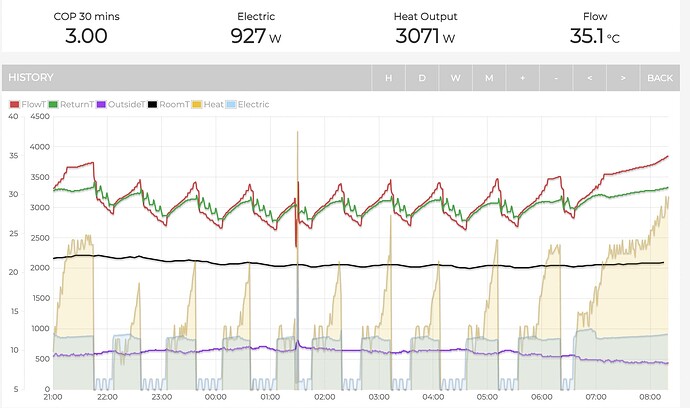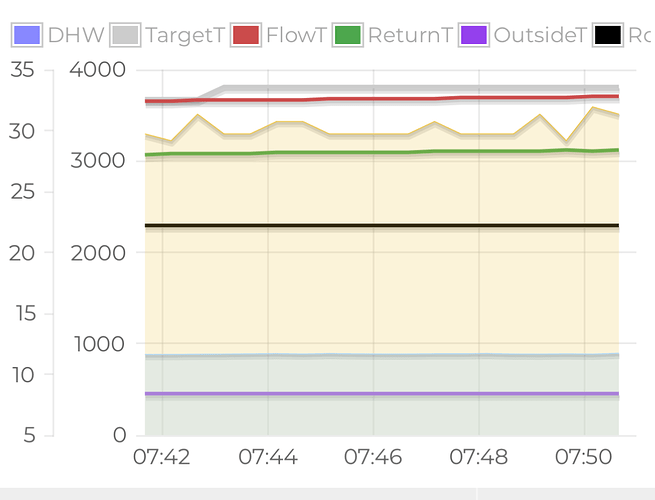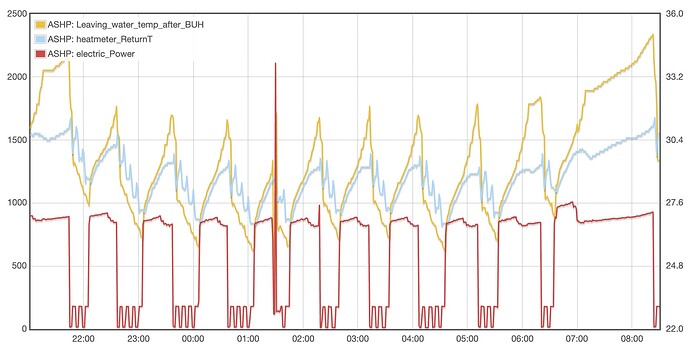It is also apparent that the ASHP uses the R2T (After BUH) value as its LWT value - just checking mine against the Onecta app, and it’s showing 33C, with the MQTT feed showing 34.9 and 33 for before/after respectively.
Hi John,
Looking at the diagram again R1T, what is called before the BUH, is potentially a long way before the BUH, it is the temperature of the water leaving the plate heat exchanger. It would have been better described as what it is, outlet plate heat exchanger water temperature.
R2T is before the circulation pump and is the actual temperature of water leaving the heat pump.
It is confirmed everywhere, the app, the MMI, in the data when looking at dT between flow and return and by my heat meter.
I’ve now got 2 HP displays, one Before and one After. Comparing from 00:00, Before shows COP 4.86, After 0.94 (!). Checking the displays on the MMI, that shows about 4kWh used, 20kWh generated, which at 5-ish (rounding) is much closer to the Before figure. What on earth is going on here??
Because the FlowT drops below the ReturnT, the energy output goes negative. How the hell is the MMI calculating this?!
Hi John,
What heat pump do you have? I don’t remember.
EDLA09D3V3 like yours
To add to the bizarreness (albeit very early days now I’ve switched sensor to RT2 (after BUH) I’m now seeing that the targetTflow doesn’t seem to tie in with this sensor.
It appears to be working alongside RT1 (pre-BUH) and is common across all models (remember RT2 sensor post BUH is only on specific models with this add-on):
This is easier to see in HA as I can see all 3 values, and as I notched by 1C the targetTflow upwards, because RT1 (pre-BUH) was already above this, it considered it satisfied.
No additional input power and the RT2 (post-BUH) only raised ever so slightly due to I would guess minimum output constraints.
Where is the target flow directed at? Presumably it is the target flow temperature out of the heat exchanger, that is RT1.
It means your target flow temperature has to be set about 1c higher than you want out of the heat pump as it loses about 1c of heat between the heat exchanger and the circulation pump.
You would expect there to be some loss.
I think maybe you are looking at this the wrong way round.
All you need to know to calculate the heat production is the temperatures entering and leaving the house and the flow rate.
If I were either you or John I would use whatever temperature reading makes you happy, either RT1 or RT2 but the only one that is representative of the heat going into your house must be the one that is reading the temperature closest to where the water leaves the heat pump.
I think if you measure the flow temperature somewhere deeper within the heat pump it would be helpful to note your data if possible so that at least other owners can make an informed comparison based on where they measure temperatures.
This HP is a piece of software, in fact several separate pieces of software, developed by likely different teams, with a few actuators and sensors attached that differ slightly by model - a typical 21stC artefact- and thus has enormous potential for bugs/“unintended features”. I think we can safely say that the HP and MMI aren’t using a consistent set of inputs for their controls and calculations!!
Hi John,
I don’t think the MMI is designed to give a detailed representation of COP, it’s a guide only.
What I do know is that the lwt and return temperatures shown by the MMI correspond to the temperatures measured by my heat meter.
The app also shows the flow temperature which corresponds with my heat meter and I have measured the actual flow with two independent clamp type thermometers which confirm the lwt is as reported at RT2.
The temperature at RT1 is higher than RT2 on all our heat pumps but as RT2 is closest to the pipe leaving the heat pump it must be the temperature that is closest to what is entering the house. How could it cool down between the heat exchanger and the BUH and then warm up again as it leaves the heat pump?
Indeed. Physics, mate.
I’d be very interested to know if in your data when the compressor isn’t working and the pump is sampling, the FlowT goes below the ReturnT, as measured by your heat meter. The screenshot shows this clearly - Flow (R2T) vs Return, with Electric Power to show pump runs.
Hi John,
My flow does go below the return at times but not by much that I can see.
I don’t see any graphs that look like you are showing though.
That doesn’t mean what you are seeing is wrong though, I don’t know how it is plumbed.
I would have thought though that the return to heat pump will be higher than the flow for a while, the return is coming from warm radiators and the flow is cooling down as the water passes through the heat pump with no heat being added, seems normal to me?
I also don’t know how your information gets from the heat pump to the heatpumpmonitor, maybe there is something not right somewhere? Or it is just the graphs are formatted slightly differently in terms of scales used for each parameter making some look different to others.
I notice the scales adjust and the lines move during the day as things like temperatures are a bigger scale once a DHW cycle is done.
I have the equipment to do what you have done as I think you know but I never managed to get HA working when I first tried and I haven’t tried gain since.
It must be fairly simple to verify the flow and return temperatures at the pipes to confirm that data you are picking up is correct?
I’m following this thread with interest, I have the smaller form factor Daikin Monobloc, 8kw with no backup heater. I’ve setup my ESP32 chip and located the x10A on my machine. I’ve bought a reconditioned mini PC to run as a Home Assistant server arriving tomorrow - finally something to put in my comms box!
Thanks Matt
That was a Graph shown by EmonCMS Setup/Graphs, clicking on the required feeds and adjusting the timescales. You can pick out any data you want, using any scale that is convenient, rather than being limited to the MyHeatpump App.
Yes, indeed, but interestingly, that is not the case if I use R1T values! Maybe the -2C difference and the residual heat exchanger heat is preventing that.
The usual path, for me - local EmonCMS, then emoncms.org, posted in HPM.org. For the new R2T-based figures, I haven’t connected to HPM yet, I’ve just configured a new, separate MyHeatpump app in the local EmonCMS. And yes, because I used Graphs to illustrate the information without the rest of the info, it looks different. Have a fiddle with Graphs, it’s very instructive.
Yes, I was rather hoping you’d volunteer to install ESPAltherma and provide some alternative data ![]() . If you have a local EmonCMS, it’s easy to make it talk directly to that instead of HA, which saves messing about with all that. If you are using only emoncms.org, then it gets a bit more tricky, although it could be modified to work with the HTTP interface rather than the MQTT one. Happy to help!
. If you have a local EmonCMS, it’s easy to make it talk directly to that instead of HA, which saves messing about with all that. If you are using only emoncms.org, then it gets a bit more tricky, although it could be modified to work with the HTTP interface rather than the MQTT one. Happy to help!
Crack on!! You can just load it with Linux/EmonCMS if you like, and feed it directly with a minor code change, if you don’t have other plans for HA. Otherwise, they can co-exist under Linux.
And at least you won’t have the Before/After afterburner, er, sorry, BackUp Heater dilemma.
I haven’t gone too deep into it just yet and I’m fairly new with regards to system admin stuff - I think my plan originally was to have it as a pure Home Assistant machine and run HAOS on it. The systems are so cheap (60-70GBP) I don’t really mind giving up the whole thing to my Home Automation tinkering, I can just buy another one to run as a File/Media server though I think there’s way to do that on HAOS anyway.
I assume I can just publish to emoncms.org rather than needing a local EmonCMS within HA?
Hi John,
Yes I would need help to do it and I need to find the parts, my wife sorts out my mess and I have a lot of plumbing mess to contend with at the moment! I don’t blame her, I’m a married single man!
I think it will be useful to have both sets of data and compare.
Honestly though, I could never use R1T for my flow, it is not the flow temperature out of the heat pump. My MMI reports R1T as 1c higher than R2T as does everybody else’s, there is a heat loss through the BUH.
R1T works on the non BUH models as that is all there is. What the heat loss is between the sensor and the water entering the house, I don’t know, and will never know.
Using the R1T temperature to calculate heat production when the LWT at R2T is known is just overstating the heat produced.
R1T with a BUH is not the LWT from the heat pump, R2T is, my data proves it.
All my opinion of course and I only really want to make my heat pump work as well as possible.
Using R1T with a BUH, in my opinion, is just making it look better than it really is.
But if any heat pump owner wants to do that then it is their business, I am not the heat pump police!
As we all know, I have billing grade heat meter and electricity meters fitted just like may others.
If I used the flow temperature from R1T in my heat pump instead of the actual flow temperature (which is the same as R2T) my heat production delivered to the house would be overstated by 15% or so.
I would be fooling myself, I don’t see the point.
Hi Matt
Yup, I get that. I’m maybe just trying to avoid spending ~ £700 (10% more!) on my shiny new HP install, and having to get someone modify the plumbing (£++), but I might still do that. Meanwhile, I’m incredibly surprised that I get very similar graphs etc. to other installations using R1T, and completely horrible ones using R2T.
I have submitted an enquiry to Daikin UK, which is now an official ticket - 114488! I asked
-
Is the big R1T/R2T difference normal?? It seems like a massive heat loss in my unused BackUp Heater. Could my R2T thermistor be defective?
-
Can you tell me which thermistor (R1T or R2T) is used for which MMI-displayed statistic? It’s like the MMI uses R2T for LWT, and R1T for COP calculation! Could there be a problem/bug between the with/without BUH versions of the Daikin EDLA09?
-
If my COP is really 1.04, that’s horrendous. Help!
Let’s see what happens. I’m not holding my breath, but the first response was
Thank you for contacting your Daikin Service Center.
On this occasion we need to escalate your query to initiate your request for technical support.
We are currently working on this and will be in contact with a further update soon.
I’m sure @marko will be along soon to explain how futile this enquiry will be! ![]()
![]()
Hi John,
I don’t understand why R2T would do anything other than influence your heat production calculation.
It is just a temperature reading, nothing more and nothing less.
I don’t think you really need the OEM system, it’s nice and I would choose it every time but money is money!
I can’t understand why changing the place you pick up the flow temperature from would have any effect on your graphs, it is just a different number for the flow temperature, what it actually is!
I think the MMI is a red herring, it doesn’t calculate COP, only heat produced, but it’s irrelevant.
COP is a measure of heat produced compared to energy consumed in doing so.
The heat delivered to your home can only be a factor of the temperature of the water going in and out and how much of it there was in a given amount of time.
To calculate the heat produced you only need to know these things,
As you don’t have a heat meter you need to find the water temperature going into and out of the home and the flow rate.
The most accurate measure of the temperature of the water going into the home must be at the point closest to the outlet from the heat pump which is R2T.
The fact that that R1T is a higher temperature and gives a higher COP is of no concern as it is not the temperature of the water leaving the heat pump and going into the home, R2T
My LWT from the MMI and the flow temperature on my heat meter are the same, that is R2T.
R1T is 1c higher but the water isn’t coming into my house directly from the heat exchanger, it is coming in after it has been through the BUH and through the temperature sensor at R2T
It may be depressing, disappointing or something else, but on a Daikin Altherma 3 with a BUH the temperature of the water leaving the heat exchanger is higher than that entering the home it is trying to heat.
It’s a fact, an indisputable fact.
Using R1T gives you heat produced after the heat exchanger, most of it goes into the home but some of it is lost between the heat exchanger and the water outlet from the heat pump, in my case the flow temperature falls by about 1c (as that is as far as the resolution on the MMI goes)
Stephen looses 0.8c and you are losing 1.8c, I can’t explain the difference as I can’t see your data.
I am running a similar flow temperature to Stephen and our difference between R1T and R2T is similar, maybe you are running a higher flow temperature and that increases the difference?
Hi John,
You can’t go from a COP of 5 to a COP of 1 just because you have lost 1.8c from your flow temperature.
Something is wrong with your data?
The heat loss through the BUH is nothing to do with whether it is used or not, it’s just a kettle in line with the flow to the house. If no electricity is being used then the water just flows through it.
I think this is a mistake, thinking we can have the water at the temperature it leaves the heat exchanger is not realistic, it is going to cool down as it passes through various components inside the heat pump.
The LWT is all that matters, if you don’t have a BUH the LWT is measured at sensor R1T (which may be in a different place to sensor R1T on BUH equipped model) and if you have a BUH the LWT is measured at sensor R2T.
I don’t think it is any more complicated than that.
I`m sorry that I havent read the discussion to the end and may be you have fixed the problem, but I think your flow rate is too low. If you use 11kW unit on radiators and target temperature oh 35 to 38 degrees you have to expext flow delta T of maximum 3 degrees. With flow delta of 3 degrees and 11 kW maximum output you need flow of 3,15m3/hour or 52,5 litres/per minute. Looking at your runs up there for 3,9kW you need 1,12m3/hour or 18,6 litres/minute. With flow around 10 litres/minute you need flow delta T around 5,6 degrees wich is massive for this target temperatures and not achievable without loss of efficiency. The result of insufficent flow is lower COP and frequent defrosting…


